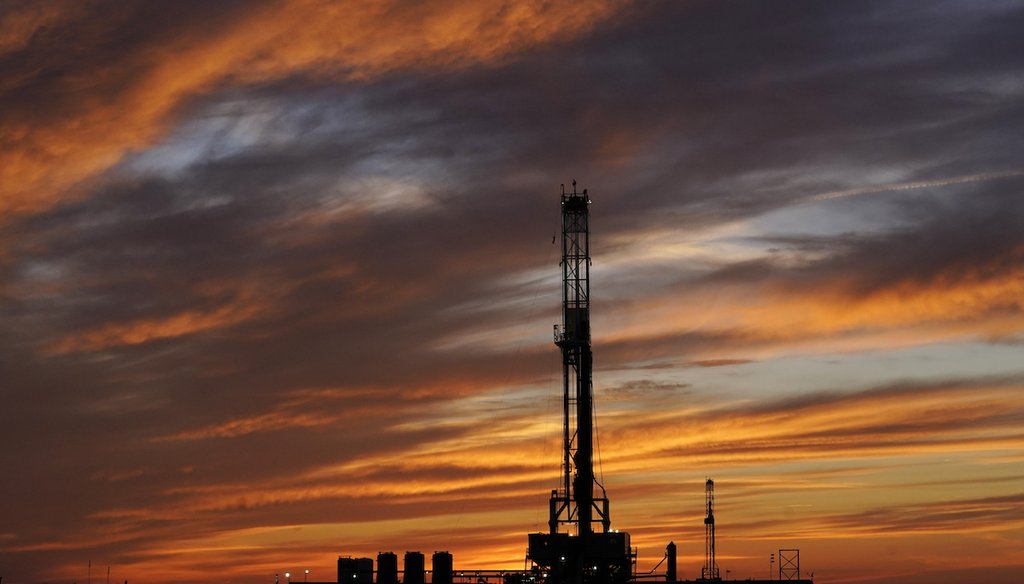

Our only agenda is to publish the truth so you can be an informed participant in democracy.
We need your help.


Oil drilling rigs are pictured at sunset, March 7, 2022, in El Reno, Oklahoma. (AP)
U.S. Rep. Morgan Luttrell, R-Texas, has flagged different energy indicators in a post online to power up his notice that energy costs are high and petroleum reserves are low.
On Jan. 10, Luttrell tweeted, "Biden drained America's Strategic Petroleum Reserves to the lowest level since 1984."
That would mean the U.S. is at supply levels it has not seen in decades. Here’s a closer look at the numbers.
Luttrell's office pointed to a September Reuters article as his source. Reuters reported U.S. emergency oil reserves dropped to 434.1 million barrels, their lowest level since October 1984.
The reserves were established in the 1970s to soften the effect of sudden oil supply reductions, according to the U.S. Energy Information Administration.
Energy administration data on the Strategic Petroleum Reserve’s weekly stock of crude oil shows there were 371,580,000 barrels as of the week ended Jan. 6.
The last time the reserve had 371 million barrels was in December 1983. Before that December, the reserve had fewer barrels. The earliest available energy administration reserve data is from 1982.
Luttrell's statistic checks out.
So, why are there fewer barrels of reserve crude oil? In March, U.S. President Joe Biden announced a directive to release 1 million barrels of crude oil per day on average for six months, totaling 180 million barrels. The White House news release said the Biden administration’s record release of oil was intended to lower rising energy costs as Russia's invasion of Ukraine disrupted supply.
A July U.S. Treasury analysis suggested that the oil released, and the release of 60 million barrels coordinated by the International Energy Agency, might have lowered the price of gasoline by 17 cents to 42 cents per gallon. The White House highlighted this analysis in an October news release announcing the administration's efforts to strengthen energy security.
Luttrell said, "Biden drained America's Strategic Petroleum Reserves to the lowest level since 1984."
Available federal data supports his claim. We rated this True.
Correction: This article was changed to accurately include the IEA 's name, International Energy Agency. This change does not affect the ruling.
Tweet by Rep. Morgan Luttrell (@repluttrell_tx8), Jan. 10, 2023
Email from Communications Director Cally Perkins at the Office of Rep. Morgan Luttrell, Jan. 10, 2023
Arathy Somasekhar, Reuters, "U.S. emergency oil reserves tumble to lowest since 1984," Sept. 12, 2022
Emails from Chris Higginbotham at U.S. Energy Information Administration Media Relations, Jan. 11, 2023
Energy Information Administration, "Weekly U.S. Ending Stocks of Crude Oil in SPR," webpage last updated Jan. 11, 2023
Energy Information Administration, "As much as 15 million barrels of crude oil sold from the U.S. Strategic Petroleum Reserve," Oct. 24, 2022
The White House, "FACT SHEET: President Biden to announce new actions to strengthen U.S. energy security, encourage production, and bring down costs," Oct. 18, 2022
The White House, "FACT SHEET: President Biden's plan to eespond to Putin's price hike at the pump," March 31, 2022
The White House, "FACT SHEET: President Biden to announce new actions to strengthen U.S. energy security encourage production, and bring down costs," Oct. 18, 2022
Email from Carey King, assistant director at the University of Texas at Austin Energy Institute, Jan. 12, 2023
U.S. Treasury Department, "The price impact of the Strategic Petroleum Reserve release," July 26, 2022
In a world of wild talk and fake news, help us stand up for the facts.
